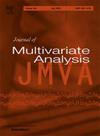Understanding asymptotic consistency and its unique advantages in large sample statistical inference
IF 1.4
3区 数学
Q2 STATISTICS & PROBABILITY
引用次数: 0
Abstract
The main objective of this paper is to investigate the usefulness of asymptotic consistency in large-sample statistical inference. In many statistical applications, plug-in methods are used to construct statistics, which raises the natural question of whether the asymptotic properties of remain unchanged when the estimator is replaced by its corresponding target quantity . We establish that if is asymptotically consistent for , meaning that , then and share identical asymptotic behaviors in terms of convergence and limiting distribution. This result notably simplifies the derivation of asymptotic properties, especially when the dependency between and is complex. Furthermore, we systematically explore the relationship between asymptotic consistency and traditional forms of consistency, such as weak and strong consistency, clarifying their distinctions through theorems and counterexamples. Finally, the theoretical findings are demonstrated via three specific applications, illustrating the practical benefits of asymptotic consistency in large-sample inference.
了解渐近一致性及其在大样本统计推断中的独特优势
本文的主要目的是研究渐近一致性在大样本统计推断中的实用性。在许多统计应用中,使用插件方法来构造统计量,这就提出了一个自然的问题:当估计量α - n被其相应的目标量α - n取代时,Tn(β - n,α - n)的渐近性质是否保持不变?我们证明了如果α αn对于αn是渐近相容的,即limn→∞P(α αn =αn)=1,则Tn(β αn, α αn)和Tn(β αn, αn)在收敛性和极限分布上具有相同的渐近性质。这个结果显著地简化了渐近性质的推导,特别是当β - n和α - n之间的依赖关系是复杂的。此外,我们系统地探讨了渐近一致性与传统形式的一致性之间的关系,如弱一致性和强一致性,并通过定理和反例澄清了它们之间的区别。最后,通过三个具体应用证明了理论发现,说明了渐近一致性在大样本推理中的实际好处。
本文章由计算机程序翻译,如有差异,请以英文原文为准。
求助全文
约1分钟内获得全文
求助全文
来源期刊

Journal of Multivariate Analysis
数学-统计学与概率论
CiteScore
2.40
自引率
25.00%
发文量
108
审稿时长
74 days
期刊介绍:
Founded in 1971, the Journal of Multivariate Analysis (JMVA) is the central venue for the publication of new, relevant methodology and particularly innovative applications pertaining to the analysis and interpretation of multidimensional data.
The journal welcomes contributions to all aspects of multivariate data analysis and modeling, including cluster analysis, discriminant analysis, factor analysis, and multidimensional continuous or discrete distribution theory. Topics of current interest include, but are not limited to, inferential aspects of
Copula modeling
Functional data analysis
Graphical modeling
High-dimensional data analysis
Image analysis
Multivariate extreme-value theory
Sparse modeling
Spatial statistics.
 求助内容:
求助内容: 应助结果提醒方式:
应助结果提醒方式:


